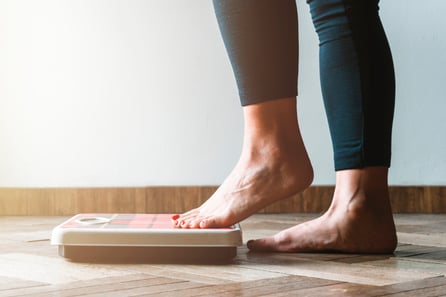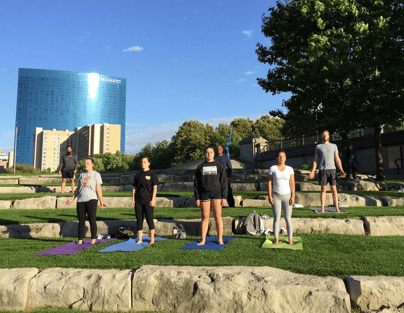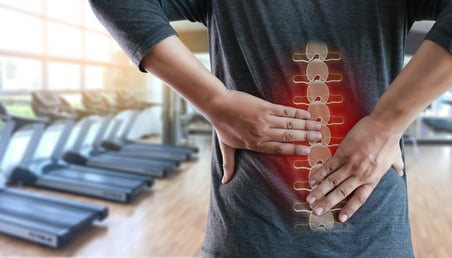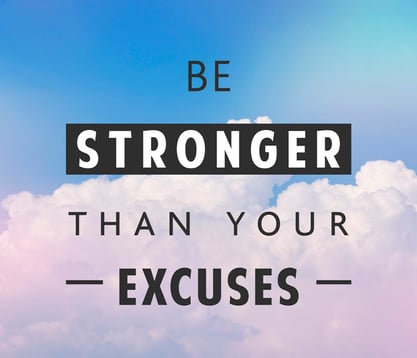 Raise your hand if you’ve been here before: You get to the end of a great workout. You’re spent, fatigued, but in a good way. In a way that you know you’ve put in some quality work. But you look down at your watch and realize you’ve run a bit over your time. So you grab your things and rush out of the gym. You don’t have time for a cool-down, right? You’ve got to get to the car and rush to the next thing on the docket.
Raise your hand if you’ve been here before: You get to the end of a great workout. You’re spent, fatigued, but in a good way. In a way that you know you’ve put in some quality work. But you look down at your watch and realize you’ve run a bit over your time. So you grab your things and rush out of the gym. You don’t have time for a cool-down, right? You’ve got to get to the car and rush to the next thing on the docket.
Without realizing it, you’ve kept up that same stimulus from your workout: that amped-up, fight-or-flight response. Only now it’s been hours since its conclusion. In short, your body has never left that stress response behind. Instead, it’s been carried around perhaps all day, and your body has not had time to transition into a rest, digest, and recovery mode. In other words, you’ve never shifted from a sympathetic (fight-or-flight) to a parasympathetic state (rest, recovery). This may sound like a “so what?” problem. But if left unchecked, this can not only stall out your workouts, but can also eventually lead to chronic issues with inflammation, sleep problems, or altered hormonal responses.
Appropriately managing your stress response isn’t something that only applies to workouts. We all face stressors on a daily, weekly, or hourly basis (perhaps in today’s world now more than ever!). If it starts to get out of hand, numerous aspects of our health and well-being are affected. Learning to mitigate and manage chronic stress can have positive effects on both physical and mental health. One way to do this is to address your vagal tone.
What Is Vagal Tone?
The longest nerve in the human body is the vagus nerve. It innervates numerous organs such as the intestines, stomach, heart, liver, and lungs (fun fact: “vagus” translates to “wanderer” in Latin; because it wanders around the body). The vagus nerve is a key part of the parasympathetic nervous system, and vagal tone refers to the activity of this nerve. If it is impaired, low vagal tone results, which is a contributor to stress and increased anxiety, a pro-inflammatory response, and a disruptor of normal gut functioning.
What Are the Benefits of Increased Vagal Tone?
A high vagal tone is associated with lower blood pressure, improved blood-sugar regulation, improved digestion, better mood, reduced anxiety, and reduced risk of stroke and cardiovascular disease. Perhaps one of the largest benefits of a higher vagal tone is the ability to relax faster after stress. So whether you’re talking physical stress from a workout or mental stress from everyday life, having an increased vagal tone can help you navigate the stressors of everyday life and be better prepared for the next one!
Additionally, researchers have discovered a positive feedback loop involving increased vagal tone, positive emotion responses, and physical and mental well-being. In short, the vagal response, or parasympathetic drive, actually works to mitigate stress and foster positive emotions. Definitely a win-win!
How Can You Increase Vagal Tone?
Okay great, now how the heck can I start working to stimulate the vagus nerve? Here are a few quick hitters that you can do today to improve your vagal tone.
Deep or Diaphragmatic Breathing
If you have virtually no time to cool down after a workout, a few deep, slow, diaphragmatic breaths can help quickly shift you toward more of a parasympathetic state. Lying on your back, elevating your legs so that your knees are at 90 degrees (on a box or bench), and taking 10–20 slow, deep breaths helps to gradually lower the heart rate and reduce blood pressure, all while stimulating the vagus nerve. Try having one hand on your upper chest and one hand over your belly button, and as you inhale try to see if your lower hand (belly) is moving upward. If you notice that only your upper hand is moving upon inhaling, take a few reps to practice filling your belly with air. This is a skill just like any other; it takes a bit of practice. But if you’re short on time, this technique is a bit of a cheat code. You can even try it before bed to help relax!
Singing, Humming, or Gargling
Yes, you read that correctly. One of the branches of the vagus nerve, the superior laryngeal nerve, actually innervates the vocal cords. As a result, we can mechanically stimulate it by singing, humming, gargling, chanting, etc. So belt out those tunes for car karaoke, hum that song that’s stuck in your head at work, and increase that vagal tone in the process!
Cold Exposure
For all us Midwesterners, we should have this one covered for about 7–8 months of the year! In all seriousness, gradually increasing your exposure to cold, and eventually becoming more habituated, causes a shift to greater parasympathetic activity. This doesn’t mean you need to go out and run two miles barefoot in the snow. You can start by splashing cold water (and I mean cold) on your face 10–20 times. Or going out to get the mail in December in a t-shirt and shorts. Or finishing off your shower with a quick 10-second blast of cold. Overall, try small interventions first to get the ball rolling. And if you’re looking for a laugh, check out my previous blog, when I put myself through hot-cold contrast showers for a week!
Omega-3s
The body cannot produce omega-3 fatty acids naturally, so they must come from the diet. They are found readily in fish (especially cold-water fish like wild-caught salmon), extra virgin olive oil, avocados, walnuts, and flaxseed, among other foods. Their benefits are wide-ranging: they positively affect brain and mental health, mitigate inflammation, and aid in improving cardiovascular health. Studies have also shown that omega-3 fatty acids also increase heart rate variability (a good thing!) and stimulate vagal activity.
Social Interaction
We are social creatures. As humans, we are hardwired to find and belong to a community. So it should come as no surprise that social connection, laughter, and having a stable support system improves our mental and physical health. While this may have been more difficult or a bit unorthodox with COVID-19, its importance has never been greater. Research has shown that laughter increases heart rate variability, and that even reminiscing about positive social connections and prior engagements improves vagal tone and increases positive emotions. So even if you can’t physically be near those you love and appreciate, making that effort to continue to reach out and connect goes a long way in your recovery from stress.
Jump-Start Your Recovery
We all face stressors on a daily basis. Whether it’s the low-level background noise of the news, or a large deadline looming in the future, learning to navigate and respond appropriately to stress is a must for maintaining physical and mental well-being. By increasing your vagal tone, you can help jump-start your recovery so that you’re more ready to tackle the next thing on your to-do list, be it a work project or a workout!

This blog was written by Lauren Zakrajsek, NIFS Assistant Fitness Center Manager, Health Fitness Instructor, and Personal Trainer. To learn more about the NIFS bloggers, click here.
 It’s no secret that our emotions impact what we eat, when we eat, and how much we eat. In fact, sometimes it seems that the strongest cravings hit when our emotional and mental well-being is at its weakest. Emotional eating is a way to, in the short term, relieve or suppress negative feelings, such as sadness, stress, anger/frustration, or boredom. However, emotional eating can also lead people to make poor choices, such as skipping or forgetting meals, consuming fast food frequently, or consuming alcohol or caffeine in excess, all of which may have health consequences, including unintentional weight gain.
It’s no secret that our emotions impact what we eat, when we eat, and how much we eat. In fact, sometimes it seems that the strongest cravings hit when our emotional and mental well-being is at its weakest. Emotional eating is a way to, in the short term, relieve or suppress negative feelings, such as sadness, stress, anger/frustration, or boredom. However, emotional eating can also lead people to make poor choices, such as skipping or forgetting meals, consuming fast food frequently, or consuming alcohol or caffeine in excess, all of which may have health consequences, including unintentional weight gain. 

 According to the
According to the 
 Raise your hand if you’ve been here before: You get to the end of a great workout. You’re spent, fatigued, but in a good way. In a way that you know you’ve put in some quality work. But you look down at your watch and realize you’ve run a bit over your time. So you grab your things and rush out of the gym. You don’t have time for a cool-down, right? You’ve got to get to the car and rush to the next thing on the docket.
Raise your hand if you’ve been here before: You get to the end of a great workout. You’re spent, fatigued, but in a good way. In a way that you know you’ve put in some quality work. But you look down at your watch and realize you’ve run a bit over your time. So you grab your things and rush out of the gym. You don’t have time for a cool-down, right? You’ve got to get to the car and rush to the next thing on the docket. 
 Do you want to be part of a community and hold yourself accountable while working out? Group fitness classes just might have what you are looking for!
Do you want to be part of a community and hold yourself accountable while working out? Group fitness classes just might have what you are looking for! 
 Today, the realities of the human body immediately after giving birth are less mysterious than ever, a development some attribute to a changing climate around motherhood. In the past women felt like they couldn’t talk about the after-effects of having a baby, let alone caring for other children at the same time.
Today, the realities of the human body immediately after giving birth are less mysterious than ever, a development some attribute to a changing climate around motherhood. In the past women felt like they couldn’t talk about the after-effects of having a baby, let alone caring for other children at the same time.  Picture this: You’re sitting in the car, in stop-and-go traffic. Your mood is just shot and all you want to do is get home. Now try this: Turn up the volume on your radio and let the music take over your soul!
Picture this: You’re sitting in the car, in stop-and-go traffic. Your mood is just shot and all you want to do is get home. Now try this: Turn up the volume on your radio and let the music take over your soul!  Take these next few weeks or so and use them to your advantage. We know this is an extremely challenging time, and we want to make sure you feel like you are taken care of. Circumstances are tricky right now, so even if you adopt one new technique, consider that a win! Don’t expect yourself to “eat the rainbow” every day, feel like you fall asleep easily at night from a relaxing day working at home in your pajamas, or get in a 10-mile run each morning. While you shelter at home and stay healthy, keep these tips in mind.
Take these next few weeks or so and use them to your advantage. We know this is an extremely challenging time, and we want to make sure you feel like you are taken care of. Circumstances are tricky right now, so even if you adopt one new technique, consider that a win! Don’t expect yourself to “eat the rainbow” every day, feel like you fall asleep easily at night from a relaxing day working at home in your pajamas, or get in a 10-mile run each morning. While you shelter at home and stay healthy, keep these tips in mind. With millions of people around the world suffering from back pain, is there any hope for relief outside of traditional methods? Low back pain can be excruciating and immobilizing, but there is still hope. When dealing with any pain or injury, exercising might be the last thing that crosses your mind, especially if it’s chronic low back pain (CLBP). However, that’s exactly what is recommended and what can help.
With millions of people around the world suffering from back pain, is there any hope for relief outside of traditional methods? Low back pain can be excruciating and immobilizing, but there is still hope. When dealing with any pain or injury, exercising might be the last thing that crosses your mind, especially if it’s chronic low back pain (CLBP). However, that’s exactly what is recommended and what can help. What’s your motivation for working out? Eat healthy? What’s your motivation to get enough sleep or practice de-stressing with yoga or foam rolling? What’s your motive to get your friends and family to go on a walk or to the gym with you?
What’s your motivation for working out? Eat healthy? What’s your motivation to get enough sleep or practice de-stressing with yoga or foam rolling? What’s your motive to get your friends and family to go on a walk or to the gym with you? Getting healthy and losing weight go hand in hand. If your goal is to get healthy and lose weight, I need you to RELAX! No, really! Relaxing is good for you, and managing stress effectively doesn’t only help with weight loss; it makes us healthier overall. So sit back, relax, and read on for more tips.
Getting healthy and losing weight go hand in hand. If your goal is to get healthy and lose weight, I need you to RELAX! No, really! Relaxing is good for you, and managing stress effectively doesn’t only help with weight loss; it makes us healthier overall. So sit back, relax, and read on for more tips.